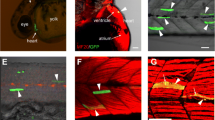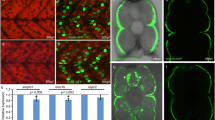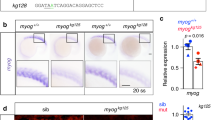Abstract
The MyoD family of basic helix-loop-helix (bHLH) myogenic regulatory factors (MRFs) are transcriptional activators of skeletal muscle gene expression and are pivotal in inducing the full myogenic program. The expression of these factors after muscle differentiation is complete and the mechanism by which they modulate (or maintain) the muscle phenotype is less well understood. The myogenically derived electric organ (EO) of the electric fish Sternopygus macrurus is an excellent model to address this question. The electrocytes, i.e., the electrogenic cells of the EO, are not contractile but they do retain some muscle proteins. In order to examine the molecular regulatory pathways that control the muscle-to-electrocyte cell conversion, we have cloned the MyoD and myogenin cDNAs from S. macrurus. Clustal-based alignments showed that the functional domains observed in mammalian MyoD and myogenin are highly conserved in these MRF homologs. Expression analyses revealed that mature electrocytes, which retain the muscle proteins dystrophin, desmin, acetylcholine receptors (AChRs), α-actin, and α-actinin, also transcribe the MyoD and myogenin genes. RT-PCR studies confirmed that expression of these MRFs is confined to the myogenic lineage. Surprisingly, the levels of MyoD and myogenin transcripts in skeletal muscle and EO could not be used to predict the level to which a cell manifests the muscle program. We conclude that expression of multiple MRFs is not sufficient to induce non-contractile cells to fully express the skeletal muscle program. These data also suggest that the MRF transcriptional program in S. macrurus may be distinct from MRF-dependent myogenesis in other vertebrate systems.






Similar content being viewed by others
References
Atchley WR, Fitch WM, Bronner-Fraser M (1994) Molecular evolution of the MyoD family of transcription factors. Proc Natl Acad Sci USA 91:11522–11526
Bass AH (1986) Electric organs revisited. In: Bullock TH (ed) Electroreception. Wiley, New York, pp 19–100
Bennett MVL (1971) Electric organs. In: Hoar WS, Randall DJ (eds) Fish physiology, vol 5. Academic, New York, pp 347–491
Bergstrom DA, Tapscott SJ (2001) Molecular distinction between specification and differentiation in the myogenic basic helix-loop-helix transcription factor family. Mol Cell Biol 21:2404–2412
Charbonnier F, Gaspera BD, Armand AS, Van der Laarse WJ, Launay T, Becker C, Gallien CL, Chanoine C (2002) Two myogenin-related genes are differentially expressed in Xenopus laevis myogenesis and differ in their ability to transactivate muscle structural genes. J Biol Chem 277:1139–1147
Chen YH, Lee WC, Cheng CH, Tsai HJ (2000) Muscle regulatory factor gene: zebrafish (Danio rerio) myogenin cDNA. Comp Biochem Physiol 127:97–103
Chen YH, Liang CT, Tsai HJ (2002) Expression, purification and DNA-binding activity of tilapia muscle-specific transcription factor, MyoD, produced in Escherichia coli. Comp Biochem Physiol B Biochem Mol Biol 131:795–805
Chin ER, Olson EN, Richardson JA, Yang Q, Humphries C, Shelton JM, Wu H, Weiguang Z, Bassel-Duby R, Sanders-Williams R (1998) A calcineurin-dependent transcriptional pathway controls skeletal muscle fiber type. Genes Dev 12:2499–2509
Choi J, Costa ML, Mermelstein CS, Chagas C, Holtzer S, Holtzer H (1990) MyoD converts primary dermal fibroblasts, chondroblasts, smooth muscle, and retinal pigmented epithelial cells into striated mononucleated myoblasts and multinucleated myotubes. Proc Natl Acad Sci USA 87:7988–7992
Clinton AS, Kim JA, Tapscott SJ, Unguez GA (2003) Molecular correlates of tail regeneration in the teleost fish S. macrurus. Soc Neurosci Abstr 41:15
Darwin C (1859) The origin of species. Penguin, New York, pp 178–179
Daubas P, Tajbakhsh S, Hadchouel J, Primig M, Buckingham M (2000) Myf5 is a novel early axonal marker in the mouse brain and is subjected to post-transcriptional regulation in neurons. Development 127:319–331
Davis RL, Weintraub H, Lassar AB (1987) Expression of a single transfected cDNA converts fibroblasts to myoblasts. Cell 51:987–1000
Delalande JM, Rescan PY (1999) Differential expression of two nonallelic MyoD genes in developing and adult myotomal musculature of the trout (Oncorhynchus mykiss). Dev Genes Evol 209:432–437
Delfini M-C, Duprez D (2003) Ectopic Myf5 or MyoD prevents the neuronal differentiation program in addition to inducing skeletal muscle differentiation, in the chick neural tube. Development 131:713–723
Emerson CP (1990) Myogenesis and developmental control genes. Curr Biol 2:1065–1075
Fox GQ, Richardson GP (1979) The developmental morphology of Torpedo marmorata: electric organ—electrogenic phase. J Comp Neurol 185:293–316
Fujisawa-Sehara A, Nabeshima Y, Komiya T, Uetsuki T, Asakura A, Nabeshima YI (1992) Differential transactivation of muscle-specific regulatory elements including myosin light chain box by chicken MyoD, myogenin, and MRF4. J Biol Chem 267:10031–10038
Gerber AN, Klesert TR, Bergstrom DA, Tapscott SJ (1997) Two domains of MyoD mediate transcriptional activation of genes in repressive chromatin: a mechanism for lineage determination in myogenesis. Genes Dev 11:436–450
Grounds MD, Garrett KI, Beilharz MW (1992) The transcription of MyoD1 and myogenin genes in thymic cells in vivo. Exp Cell Res 198:357–361
Gullick WJ, Lindstrom JM (1982) The antigenic structure of the acetylcholine receptor from Torpedo californica. J Cell Biochem 19:223–230
Hughes SM, Taylor JM, Tapscott SJ, Gurley CM, Carter WJ, Peterson CA (1993) Selective accumulation of MyoD and myogenin mRNAs in fast and slow adult skeletal muscle is controlled by innervation and hormones. Development 118:1137–1147
Jasmin BJ, Cartaud A, Ludosky MA, Changeux JP, Cartaud J (1990) Asymmetric distribution of dystrophin in developing and adult Torpedo marmorata electrocyte: evidence for its association with the acetylcholine receptor-rich membrane. Proc Natl Acad Sci USA 87:3938–3941
Kobiyama A, Nihei Y, Hirayama Y, Kikuchi K, Suetake H, Johnston IA, Watabe S (1998) Molecular cloning and developmental expression patterns of the MyoD and MEF2 families of muscle transcription factors in the carp. J Exp Biol 201:2801–2813
Ma PCM, Rould MA, Weintraub H, Pabo CO (1994) Crystal structure of MyoD bHLH domain-DNA complex: perspectives on DNA recognition and implications for transcriptional activation. Cell 77:451–459
Mayer DC, Leinwand LA (1997) Sarcomeric gene expression and contractility in myofibroblasts. J Cell Biol 139:1477–1484
Meyer A, Schartl M (1999) Gene and genome duplication in vertebrates: the one-to-four (-to-eight in fish) rule and the evolution of novel gene functions. Curr Opin Cell Biol 11:699–704
Miller JC (1991) Myoblasts, myosins, MyoDs, and the diversification of muscle fibers. Neuromusc Disorders 1:7–17
Mills A, Zakon HH, Marchaterre MA, Bass AH (1992) Electric organ morphology of Sternopygus macrurus, a wave-type, weakly electric fish with a sexually dimorphic EOD. J Neurobiol 23:920–932
Nabeshima Y, Hanaoka K, Hayasaka M, Esumi E, Li S, Nonaka I, Nabeshima Y (1993) Myogenin gene disruption results in perinatal lethality because of severe muscle defect. Nature 364:532–535
Neville CM, Schmidt J (1992) Expression of myogenic factors in skeletal muscle and electric organ of Torpedo californica. FEBS Lett 305:23–26
Patterson JM, Zakon HH (1993) Differential expression of proteins in muscle and electric organ, a muscle derivative. J Comp Neurol 370:367–376
Patterson JM, Zakon HH (1996) Bromodeoxyuridine labeling reveals a class of satellite-like cells within the electric organ. J Neurobiol 24:660–674
Patterson JM, Zakon HH (1997) Transdifferentiation of muscle to electric organ: regulation of muscle-specific proteins is independent of patterned nerve activity. Dev Biol 186:115–126
Pownall ME, Gustafsson MK, Emerson CP Jr (2002) Myogenic regulatory factors and the specification of muscle progenitors in vertebrates embryos. Annu Rev Cell Dev Biol 18:747–783
Rescan P, Gauvry L (1996) Genome of the rainbow trout (Oncorhynchus mykiss) encodes two distinct muscle regulatory factors. Comp Biochem Physiol 113:711–715
Rescan PY, Gauvry L, Paboeuf G (1995) A gene with homology to myogenin is expressed in developing myotomal musculature of the rainbow trout and in vitro during the conversion of myosatellite cells to myotubes. FEBS Lett 362(1):89–92
Rhodes SJ, Konieczny SF (1989) Identification of MRF4: a new member of the muscle regulatory factor gene family. Genes Dev 3:2050–2061
Robinson-Rechavi M, Marchand O, Escriva H, Laudet V (2001) An ancestral whole genome duplication may not have been responsible for abundance of duplicated fish genes. Curr Biol 11:781–788
Rome LC, Choi IH, Lutz G, Sosnicki A (1992) The influence of temperature on muscle function in the fast swimming scup. I. Shortening velocity and muscle recruitment during swimming. J Exp Biol 163:259–279
Rome LC, Syme DA, Hollingworth S, Lindstedt SL, Baylor SM (1996) The whistle and the rattle: the design of sound-producing muscles. Proc Natl Acad Sci USA 93:8095–8100
Rudnicki MA, Schnegelsbert PN, Stead RH, Braun T, Arnold HH, Jaenisch R (1993) MyoD or Myf-5 is required for the formation of skeletal muscle. Cell 75:1351–1359
Saito M, Kanda S, Kunisaki N, Kimura S (2001) Complete primary structure of rainbow trout muscle glyceraldehyde 3-phosphate dehydrogenase. J Kagawa Nutri Univ 32:27–32
Sambrook J, Fritsch EF, Maniatis T (1989) In: Chris Nolan (ed) Molecular cloning: a laboratory manual, 2nd edn. Cold Spring Harbor Laboratory Press, pp 7.19–7.22
Scales JB, Olson EN, Perry M (1991) Differential expression of two distinct MyoD genes in Xenopus. Cell Growth Differ 2:619–629
Schwarz JJ, Chakraborty T, Martin J, Zhou JM, Olson EN (1992) The basic region of myogenin cooperates with two transcription activation domains to induce muscle-specific transcription. Mol Cell Biol 12:266–275
Takebayashi-Suzuki K, Pauliks LB, Eltsefon Y, Mikawa T (2001) Purkinje fibers of the avian heart express a myogenic transcription factor program distinct from cardiac and skeletal muscle. Dev Biol 234:390–401
Tan X, Du SJ (2002) Differential expression of two MyoD genes in fast and slow muscles of gilthead seabream (Sparatus aurata). Dev Genes Evol 212:207–217
Tricarico C, Pinzani P, Bianchi S, Paglierani M, Distante V, Passagli M, Bustin SA, Orlando C (2002) Quantitative real-time reverse transcription polymerase chain reaction: normalization to rRNA or single housekeeping genes is inappropriate for human tissue biopsies. Anal Biochem 309:296–300
Unguez GA, Zakon HH (1998a) Phenotypic conversion of distinct muscle fiber populations to electrocytes in a weakly electric fish. J Comp Neurobiol 399:20–34
Unguez GA, Zakon HH (1998b) Reexpression of myogenic proteins in mature electric organ after removal of neural input. J Neurosci 18:9924–9935
Unguez GA, Zakon HH (2002) Skeletal muscle transformation into electric organ in Sternopygus macrurus depends on innervation. J Neurobiol 53:391–402
Voytik Sl, Prizyborski M, Badylak SFG, Konieczny SF (1993) Differential expression of muscle regulatory factor genes in normal and denervated adult rat hindlimb muscle. Dev Dyn 198:214–224
Walker JH, Boustead CM, Witzemann V, Shaw G, Weber K, Osborn M (1985) Cytoskeletal proteins at the cholinergic synapse: distribution of desmin, actin, fodrin, neurofilaments, and tubulin in Torpedo electric organ. Eur J Cell Biol 38:123–133
Walters EH, Stickland NC, Loughna PT (2000) MRF4 exhibits fiber type- and muscle-specific pattern of expression in postnatal rat muscle. Am J Physiol Regul Integr Comp Physiol 278:1381–1384
Weintraub H (1993) The MyoD family and myogenesis: redundancy, networks, and thresholds. Cell 75:1241–1244
Weintraub H, Tapscott SJ, Davis RL, Thayer MJ, Lassar AB, Miller AD (1989) Activation of muscle-specific genes in pigment, nerve, fat, liver, and fibroblast cell lines by forced expression of MyoD. Proc Natl Acad Sci USA 86:5434–5438
Weintraub H, Dwarki VJ, Verma I, Davis R, Hollenbert S, Snider L, Lassar A, Tapscott SJ (1991) Muscle-specific transcriptional activation by MyoD. Genes Dev 5:1377–1386
Wheeler MT, Snyder EC, Patterson MN, Swoap SJ (1999) An E-box within the MHC IIB gene is bound by MyoD and is required for gene expression in fast muscle. Am J Physiol 276:C1069–C1078
Yutzey KE, Rhodes SJ, Konieczny SF (1990) Differential transactivation associated with the muscle regulatory factors MyoD, myogenin and MRF4. Mol Cell Biol 10:3934–3944
Zhang J-M, Chen L, Krause AF, Patterson BM (1999) Evolutionary conservation of MyoD function and differential utilization of E proteins. Dev Biol 208:465–472
Acknowledgements
This research was supported by National Institute of Health Grants S06-GM08136-27 and RR16480-01 (G.A.U.). We are grateful to Michael Peck and Xiaolin Xu for technical assistance in early studies of cloning and northern blot analysis; Dr. Dominique Mornet (Institut Bousson-Bertrand, Montpellier, France) for dystrophin antibodies; and Steve Konieczny and Harold Zakon for critical reading of the manuscript.
Author information
Authors and Affiliations
Corresponding author
Additional information
Edited by R.P. Elinson
Rights and permissions
About this article
Cite this article
Kim, J.A., Jonsson, C.B., Calderone, T. et al. Transcription of MyoD and myogenin in the non-contractile electrogenic cells of the weakly electric fish, Sternopygus macrurus. Dev Genes Evol 214, 380–392 (2004). https://doi.org/10.1007/s00427-004-0421-5
Received:
Accepted:
Published:
Issue Date:
DOI: https://doi.org/10.1007/s00427-004-0421-5




